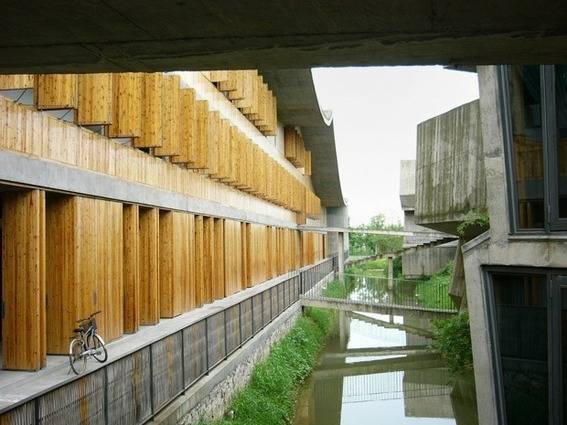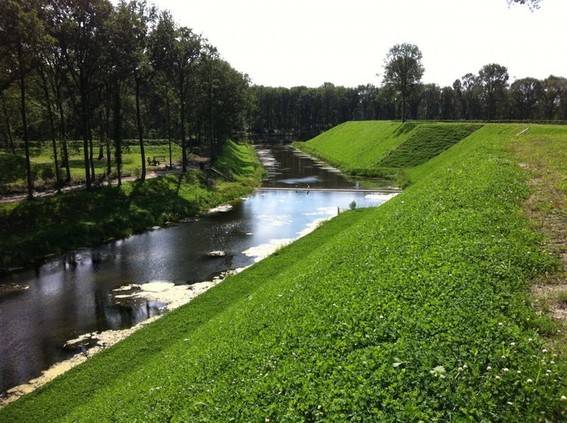Over at EcoSalon this past month – where Shelter is where the heart is and the green is always greener – we obsessed over Pantone in theory (the app) vs. practice (the hotel); celebrated Valentine’s Day like practical gals and fixed up a broken heart; font-renewed and blissed out; voyeured our way into the homes of some of our favorite design bloggers and curators and prodded the real life ethics of one of America’s most up-and-coming box store furniture purveyors.
But that is not all. Oh no, that is not all.
Here’s what else happened this month in sustainable, green design and architecture that I’ve been saving just for Curbly. 
On Campus
In the UK, one of the Europe’s largest prefabricated straw bale buildings opened at The University of Nottingham. Designed by Make Architects, the building (dubbed Gateway) was constructed with over 1,954 straw bales harvested on nearby farmland.

The highly insulating straw produces minimal carbon output and will be used for offices, labs, seminar and computer rooms…a-level stuff that would make the Scarecrow from the Wizard of Oz appreciate his own brilliance.
See Make’s video for more on the not-so-fabled process:
Via Archinect.

In Competition
Always a fan of the mason jar, the winner of the Green Furniture Sweden Awards has taken fruit preservation to another level. This adjustable oak lamp, firmly clamped in simple Scandinavian chic, is made from recycled jam jars. Orchids, meanwhile, informed the design.

In the Pantry
Refrigerators are big time energy consumers that ice you out of a significant chunk of change each month. What’s worse is that refrigerators eat your produce, don’t they? They make your veggies mealy, wilty or just plain uninspiring. They’re capable of disappearing eggplant altogether chucking out a sea foam covered rugby ball in return.

Designer Jihyun Ryou has come up with a much more energy efficient and pretty way of preserving food the natural way using wood, glass, rice, sand and water.
Very cool concept (pun intended, I guess) that could almost be DIY.
Via Fast Company

In China
China’s reputation for growth precedes itself, quite literally, accounting for the brown haze that hovers around its most populous cities; the other two-thirds of cities, meanwhile, exhibit subpar air standards. Build, baby, build has seemingly been the mantra for the burgeoning economic giant but with the announcement of this year’s Pritzker Prize, might it herald a new era of slow, sustainable architecture?

Wang Shu has been garnering worldwide praise for using traditional construction techniques and salvaged materials with a mindset towards sustainability. Now he is the nation’s first winner of the prestigious prize.
“The fact that an architect from China has been selected by the jury represents a significant step in acknowledging the role that China will play in the development of architectural ideals,” said Thomas J. Pritzker, head of the Hyatt Foundation, said during the announcement.
Images via The New Yorker and Smart Planet

In Re-Use
Back in the 17th century, moats were essential for warding off n’er do wellers and other enemies, especially among the powerful landed gentry of the Netherlands. In this day and age, they’re considered useless holes in the ground – many would even consider them pompous mosquito traps.
The Dutch design firm RO&AD Architecten has put one such moat back into creative (almost biblical) re-use.
The West Brabant Water Line was a defense line protecting a number of fortresses and cities in the southwest region of the country. This unusual access bridge crosses from the outlying territory to Fort de Roovere, used mostly by cyclists, hikers, runners and anyone channeling their inner Charlton Heston (in terms of cinema, one would hope, not firearms).

Because I’m always interested in ending things on a light and pretty note, some eye candy pinned just the other day on our Pinterest shelter board (an eco forest lodge in, where else, Sweden). If you come across anything ripe for pinning, suggest it to us by tagging @ecosalon.
Via archdaily and RO&AD Architecten.
